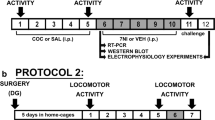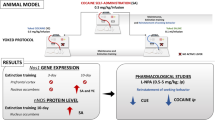Abstract
Previous studies proposed the involvement of theN-methyl-D-aspartate (NMDA) type of glutamate receptors in the development of sensitization to the convulsive effect of cocaine (cocaine kindling). The present study was undertaken to determine, first, if cocaine kindling is associated with enhanced sensitivity of the NMDA receptor to the convulsive response ofN-methyl-D,L-aspartate (NMDLA), and second, whether in vivo modulation of nitric oxide synthase (NOS) function regulates the development of cocaine kindling. The following results were observed:
-
1.
Cocaine-kindled animals were significantly more susceptible to the convulsive effect of the NMDA receptor agonist NMDLA than saline controls;
-
2.
Pretreatment with the NOS inhibitor NG-nitro-L-arginine methyl ester (L-NAME; 100 mg/kg; ip) blocked the development of cocaine kindling;
-
3.
The protective effect of L-NAME was partially reversed with the coadministration of the NOS substrate,L-arginine (300 mg/kg; ip), but notD-arginine; and
-
4.
L-Arginine (300 mg/kg; ip), but notD-arginine, amplified the development of cocaine kindling. Taken together, these findings suggest that supersensitivity of the NMDA receptor and activation of NOS may underlie the development of cocaine kindling.
Similar content being viewed by others
References
Alldredge B. K., Lowenstein D. H., and Simon R. P. (1989) Seizures associated with recreational drug abuse.Neurology 39, 1037–1039.
Bagetta G., Massoud R., Rodino P., Federici G., and Nistico C. (1993) Systemic administration of LiCl and tacrine increases nitric oxide synthase activity in the hippocampus of rats.Eur. J. Pharmacol. 237, 61–64.
Bredt D. S. and Snyder S. H. (1989) Nitric oxide mediates glutamate-linked enhancement of cGMP levels in the cerebellum.Proc. Natl. Acad. Sci. USA 86, 9030–9033.
De Sarro G. B., Di Paola E. D., De Sarro A., and Vidal M. J. (1991) Role of nitric oxide in the genesis of excitatory amino acid-induced seizures from the deep prepiriform cortex.Fund. Clin. Pharmacol. 5, 503–511.
Dhuna A., Pascual-Leone A., and Langendorf F. (1991) Chronic habitual cocaine abuse and kindling induced epilepsy: a case report.Epilepsia 32, 890–894.
Gally J. A., Montague P. R., Reeke G. N., and Edelman G. M. (1991) The NO hypothesis: possible effects of a short-lived rapidly diffusible signal in the development and function of the nervous system.Proc. Natl. Acad. Sci. USA 87, 3547–3551.
Garthwaite J. (1991) Glutamate nitric oxide and cell-cell signalling in the nervous system.Trends Neurosci. 14, 60–67.
Garthwaite J., Charles S. L., and Chess-Williams R. (1988) Endothelium-derived relaxing factor release on activation of NMDA receptors suggest role as intracellular messenger in brain.Nature 336, 385–388.
Gross P. M., Weaver D. F., Bowers R. J., Nag S., Ho L. T., Pang J. J., and Espinosa F. J. (1994) Neurotoxicity in conscious rats following intraventricular SNAP, a nitric oxide donor.Neuropharmacology 33, 915–927.
Itzhak Y. (1993) Nitric oxide (NO) synthase inhibitors abolish cocaine-induced toxicity in mice.Neuropharmacology 32, 1069,1070.
Itzhak Y. (1994) Blockade of sensitization to toxic effects of cocaine in mice by nitric oxide synthase inhibitors.Pharmacol. Toxicol. 74, 162–166.
Itzhak Y. and Stein I. (1992) Sensitization to the toxic effects of cocaine in mice is associated with the regulation of theN-methyl-d-aspartate receptors in the cortex.J. Pharmacol. Exp. Ther. 262, 464–470.
Johanson C.-E. and Fischman M. W. (1989) The pharmacology of cocaine related to its abuse.Pharmacol. Rev. 41, 3–52.
Karler R. and Calder L. D. (1992) Excitatory amino acids and the actions of cocaine.Brain Res. 582, 143–146.
Karler R., Calder L. D., Chaudhry I. A., and Turkanis S. A (1989) Blockade of “reverse tolerance” to cocaine and amphetamine by MK-801.Life Sci. 45, 599–606.
Karler R., Calder L. D., and Bedingfield B. J. (1994) Cocaine behavioral sensitization and excitatory amino acids.Psychopharmacology 115, 305–310.
Lonart G., Cassels K. L., and Johnson K. M. (1993) Nitric oxide induces calcium-dependent [3H] dopamine release from striatal slices.J. Neurosci. Res. 35, 192–198.
Louie A. K., Lannon R. A., and Ketter T. A. (1989) Treatment of cocaine-induced panic disorders.Am. J. Psychiatry 146, 40–44.
Mody I. (1993) The molecular basis of kindling.Brain Pathol. 3, 395–403.
Mollace V., Bagetta G., and Nistico G. (1991) Evidence thatl-arginine possesses pro-convulsant effects mediated through nitric oxide.NeuroReport 2, 269–272.
Montague P. R., Gancayco C. D., Winn M. J., Marchase R. B., and Friedlander M. J. (1994) Role of NO production in NMDA receptor-mediated neurotransmitter release in cerebral cortex.Science 263, 973–977.
Post R. M. (1977) Progressive changes in behavior and seizures following chronic cocaine administration: relationship to kindling and psychosis, inCocaine and Other Stimulants (Creese I., ed.), Raven, New York, pp. 169–203.
Post R. M., Wiess S. R., and Pert A. (1988) Cocaine-induced behavioral sensitization and kindling: implications for the emergence of psychopathology and seizures, inThe Mesocorticolimbic Dopamine System (Kalivas P. W. and Nemeroff C. B., eds.), Annals of the New York Academy of Science, vol. 537, The New York Academy of Science, New York, pp. 292–308.
Racine R. (1978) Kindling: the first decade.Neurosurgery 3, 234–252.
Shuster L., Yu G., and Bates A. (1977) Sensitization to cocaine stimulation in mice.Psychopharmacology 52, 185–190.
Snyder S. H. (1992) Nitric oxide: first in a new class of neurotransmitters?Science 257, 494–496.
Stripling J. S. and Ellinwood E. H. (1977) Sensitization to cocaine following chronic administration in rat, inCocaine and Other Stimulants (Ellinwood E. H. and Kilbet M. M., eds.), Plenum, New York, pp. 327–351.
Zhu X.-Z. and Luo L.-G. (1992) Effect of nitroprusside (nitric oxide) on endogenous dopamine release from rat striatal slices.J. Neurochem. 59, 932–935.
Author information
Authors and Affiliations
Rights and permissions
About this article
Cite this article
Itzhak, Y. Cocaine kindling in mice. Mol Neurobiol 11, 217–222 (1995). https://doi.org/10.1007/BF02740696
Issue Date:
DOI: https://doi.org/10.1007/BF02740696




